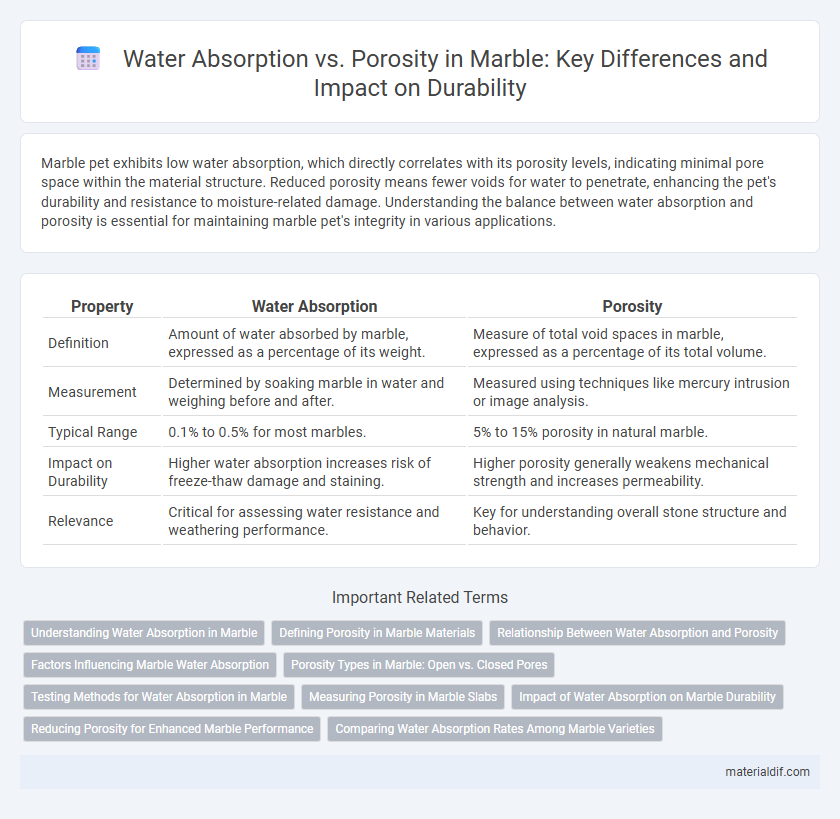Marble pet exhibits low water absorption, which directly correlates with its porosity levels, indicating minimal pore space within the material structure. Reduced porosity means fewer voids for water to penetrate, enhancing the pet's durability and resistance to moisture-related damage. Understanding the balance between water absorption and porosity is essential for maintaining marble pet's integrity in various applications.
Table of Comparison
| Property | Water Absorption | Porosity |
|---|---|---|
| Definition | Amount of water absorbed by marble, expressed as a percentage of its weight. | Measure of total void spaces in marble, expressed as a percentage of its total volume. |
| Measurement | Determined by soaking marble in water and weighing before and after. | Measured using techniques like mercury intrusion or image analysis. |
| Typical Range | 0.1% to 0.5% for most marbles. | 5% to 15% porosity in natural marble. |
| Impact on Durability | Higher water absorption increases risk of freeze-thaw damage and staining. | Higher porosity generally weakens mechanical strength and increases permeability. |
| Relevance | Critical for assessing water resistance and weathering performance. | Key for understanding overall stone structure and behavior. |
Understanding Water Absorption in Marble
Water absorption in marble directly correlates with the stone's porosity, as higher porosity allows more water to penetrate its surface, leading to increased absorption rates. Marble typically exhibits porosity levels ranging from 0.1% to 1%, where low porosity minimizes water uptake and enhances durability in wet environments. Understanding these characteristics is crucial for applications requiring moisture resistance, as excessive water absorption can cause staining, structural weakening, and surface deterioration in marble installations.
Defining Porosity in Marble Materials
Porosity in marble materials refers to the volume percentage of void spaces within the stone that can potentially hold fluids. This intrinsic property directly influences water absorption rates, as higher porosity typically allows greater water penetration, compromising durability and appearance. Understanding porosity is critical for assessing marble's suitability in various applications, especially where moisture exposure is a concern.
Relationship Between Water Absorption and Porosity
Water absorption in marble is directly influenced by its porosity, as higher porosity allows more water to penetrate the stone's microstructure. Porosity determines the volume of void spaces within marble, which serve as channels for water ingress, affecting durability and stain resistance. Understanding this relationship is critical for selecting marble in environments exposed to moisture, ensuring longevity and maintaining aesthetic quality.
Factors Influencing Marble Water Absorption
Marble's water absorption is primarily influenced by its porosity, which depends on the mineral composition and grain size distribution within the stone. Higher porosity levels allow more water to penetrate, increasing susceptibility to staining and weathering. Environmental factors such as temperature, humidity, and surface treatment also critically affect marble's effective water absorption rate.
Porosity Types in Marble: Open vs. Closed Pores
Porosity in marble consists of open and closed pores, which significantly influence water absorption rates. Open pores connect to the marble's surface, allowing water to penetrate easily, increasing susceptibility to staining and damage. Closed pores are sealed within the stone, limiting water absorption and enhancing marble's durability and resistance to moisture-related issues.
Testing Methods for Water Absorption in Marble
Water absorption in marble is commonly tested using methods such as the cold water absorption test and boiling water absorption test, both measuring the percentage of water uptake relative to the sample's dry weight. Porosity directly influences water absorption rates, as highly porous marble exhibits greater water retention, affecting durability and resistance to staining. Precise testing ensures accurate assessment of marble's quality for construction and restoration applications.
Measuring Porosity in Marble Slabs
Measuring porosity in marble slabs involves calculating the volume of open pores relative to the total volume, which directly impacts water absorption rates. Techniques such as mercury intrusion porosimetry and vacuum saturation tests provide precise porosity values, essential for predicting marble's durability and resistance to staining. Low porosity marble typically exhibits minimal water absorption, making it ideal for high-moisture environments and enhancing its longevity.
Impact of Water Absorption on Marble Durability
Water absorption in marble directly correlates with its porosity, as higher porosity allows more water to penetrate the stone's microstructure. Increased water absorption accelerates deterioration through freeze-thaw cycles, chemical reactions, and biological growth, significantly compromising marble durability. Therefore, low water absorption levels are critical for preserving marble's structural integrity and aesthetic quality over time.
Reducing Porosity for Enhanced Marble Performance
Reducing porosity in marble significantly decreases water absorption, improving durability and resistance to staining. Low porosity levels help maintain the stone's structural integrity by minimizing moisture intrusion that can cause cracking or deterioration. Enhancing marble performance involves sealing pores to create a denser, less permeable surface that extends the lifespan of both natural and engineered marble materials.
Comparing Water Absorption Rates Among Marble Varieties
Different marble varieties exhibit varying water absorption rates directly linked to their porosity levels, with high-porosity marbles like Crema Marfil absorbing water up to 0.3%, while denser types such as Carrara show rates as low as 0.05%. This variability affects durability and maintenance, as marbles with higher water absorption are more prone to staining and moisture damage. Understanding these differences is crucial for selecting marble suited to specific environmental conditions and usage.
Water absorption vs Porosity Infographic

 materialdif.com
materialdif.com